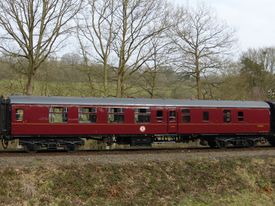BR 35219 Brake Corridor Second
| BR 35219 Brake Corridor Second | |
|---|---|
 BR Brake Corridor Second 35219 | |
| Built By | BR Wolverton |
| Status | In service |
| Number | M35219 |
| Livery | BR Maroon |
| Other numbers | M35219, 99850 |
| History | |
| Built | 1958 |
| Diagram | 181 |
| Lot | 30427 |
| Type | BSK |
| TOPS code | AB21 |
| Seats | 24 standard |
| 1976 | Preserved as main line support coach |
| 1995 | Arrived on SVR |
Contents
35219 in service and preservation
35219 was built at BR's Wolverton works in 1958 to Diagram 181 (AB201), Lot 30427. It entered service in the London Midland region in 1958, remaining in service in that region until October 1975.[3] During a repair in the early 1960s it was fitted with a rare type of window assembly on the main body lights.[1]
35219 was preserved in 1976, having been bought by the 6000 Locomotive Association for use as the main line support vehicle for preserved King Class GWR 4-6-0 No 6000 King George V. Shortly after it was acquired, the coach went to Swindon for attention, and while there the emergency wrecking kit provided in the corridor wall was fully stocked up.[1]
Based at the Bulmers Railway Centre at Hereford, 35219 regularly took part in open days there and also ran many excursions with 'KGV' including several to the SVR with the 'Bulmers Cider Train'.[1] By 1988 it had received the TOPS number 99850, the '99' series being Private User vehicles.[3]
'KGV' was eventually withdrawn to the National Collection, removing the need for a support coach.[1] Following the closure of the Hereford steam centre, 35219 arrived on the SVR from there on 22 July 1995.[2] At the time of its arrival it was still owned by the 6000 Locomotive Association. A number of Association members helped with the mechanical overhaul at Kidderminster Carriage Works during 1997 and subsequently went on to work on other carriages. 35219 was made ready for SVR service in early 1998,[4] entering traffic still carrying its fading 6000 Locomotive Association maroon.[1]
During the 2003 1940s Weekend, 35219 was "...dragged by unknown means" and suffered severe wheel flats. The coach was red-carded pending wheel turning, for which the coach visited Toton to use the ground-level lathe there, it being considered "more economical to spend £100 on road transport than it is to employ three full-time staff for a fortnight to take the wheels out of the bogies and just send them on their own".[5]
The following summer 35219 suffered a "rough shunt" when a locomotive was buffered up too heavily. Examination revealed that a centre casting had fractured.[note 2] A replacement centre casting, salvaged from a BR Suburban coach cut up at Kidderminster about 7 years previously, was fitted, with 35219 returning to service in the LNER set by mid-September 2004.[6]
In 2006 the 6000 Locomotive Association carried out legal searches for past donors to their now-defunct fund, after which they vested ownership of 35219 with the SVR Rolling Stock Trust. Following this transfer, the Trust supplied new batteries and 'slow speed charging kits' compatible with the coach's standard 90mph oil axle box bogies,[7] and shortly afterwards the worn upholstery was replaced with replica BR/LMS pattern cloth.[1] 35219 was then put through Bewdley paint shop between April and June 2007 for further repairs, including a full repaint into BR 1958 maroon livery.[8] The interior was also re-fitted to replicate the original 1950s condition.
35219 suffered a burst pipe in late 2012. It underwent repairs outdoors at Kidderminster; inspection revealed a number of other loose and broken items which were rectified and all eight luggage racks were given new nets at the same time.[9] After spending the winter in Set M at Bridgnorth, 35219 required attention to the seating for safety reasons after staples were found to have pulled out of the seating.[10]
From time to time carriages undergo repairs in the Kidderminster Carriage Shed rather than the main Carriage Repair Works. During summer 2014 35219 underwent repairs there, including the removal of the roof tank for repairs and patch-plating of the roof which was also painted 'under the wire' on road CS3. 35219 was then moved to road CS4 which had been equipped with a hired scaffold platform (gaining the nickname "platform 9¾" in the process), where it was repainted. A brief visit to the main works was required to repair the filler pipes which had disintegrated when the roof tank was removed. Work on 35219 was finished on 28 September but it was withheld from that year's Diesel Gala to allow the varnish to finish hardening.[11] It subsequently took part in the 2014 Christmas services, becoming very heavily soiled in the process, after which cleaning produced scratches in the new surface which may not have hardened as hoped. 35219 therefore returned to Carriage Works for a week in early 2015 for a clean and quick revarnish.[12]
Other more recent repairs have included a new set of batteries after the existing set had been weakened by having the luggage area lights left on twice during the 2015 Christmas services,[13] and a new brake cylinder in early 2020.[14]
35219 is normally used in Set M, the BR Maroon running set, and is owned by the SVR Charitable Trust.
See also
Notes
- ↑ Mark 1 BSKs built for the Western and Southern regions seated eight per compartment for a total of 32, those built for other regions (including 35219) seated six per compartment for a total of 24.
- ↑ The castings come as interlocking pairs, one of which is bolted to the underside of the coach chassis and the other to the top of the bogie bolster, allowing the bogie to pivot on curves.
References
Links
| ||||||||||||||||||||||||||||||